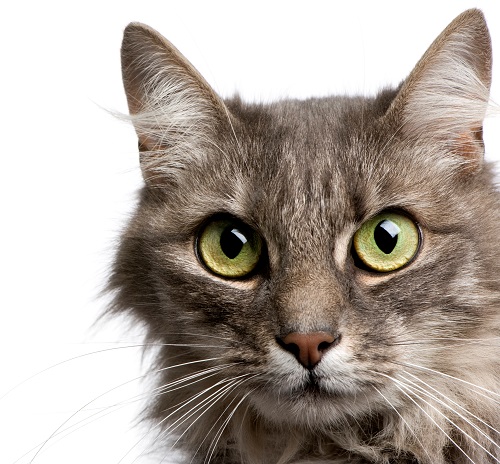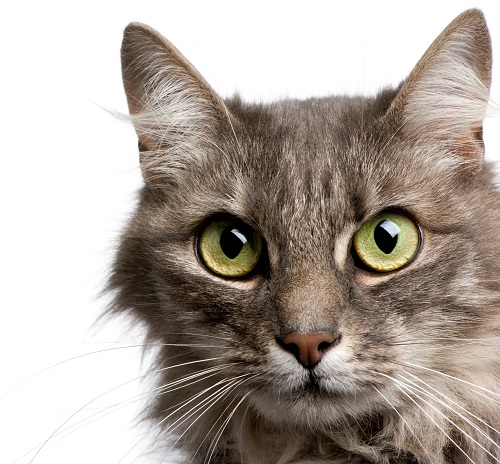 How does Feline Immunodeficiency Virus (FIV) compare to Human Immunodeficiency virus (HIV)?
How does Feline Immunodeficiency Virus (FIV) compare to Human Immunodeficiency virus (HIV)?
Feline immunodeficiency Virus (FIV) has similar building blocks and is related to Human Immunodeficiency Virus (HIV), but very importantly, it cannot be passed between cats and humans. The virus can also not be transmitted from cats to dogs. Both FIV and HIV viruses share a similar pattern of disease progression. Both viruses are classified as Lentivirus, which means they have a long period of showing very few clinical signs during which time the immune system deteriorates. Eventually Acquired Immunodeficiency Syndrome (AIDS) develops and this is accompanied by opportunistic infections, systemic disease and cancer. The close relationship between FIV and HIV has meant that FIV has been used as an animal study model to better understand HIV in humans.
FIV was first described in domestic cats in 1987 but data suggests that wild cats may have been affected for much longer. It has been found that the majority of lions are infected with FIV but few show clinical signs.
How is FIV transmitted?
FIV is passed between cats by contact (also referred to as horizontal transmission) and not from a mother to her unborn kittens. Male cats that have not been neutered and living outdoors have been found to be most at risk. The virus is found in the saliva of infected cats and is most commonly transmitted through bite wounds with fighting. Although it is also found in the semen of infected males, sexual transmission, unlike in HIV, is uncommon. The true prevalence of the disease is not known because testing is completely voluntary. The prevalence is highly variable and depends on the age, gender, lifestyle, physical condition and geographic location of the cat.
What are the symptoms of Cat Aids?
Similarly with humans, infection with FIV virus does not immediately lead to full blown aids. Acute FIV infection is often associated with mild clinical signs, which usually go unnoticed by pet owners. Cats may have occasional fever, decreased white blood cell counts and enlarged lymph nodes. High concentrations of the virus can be detected in the blood as early as two weeks after infection. Initial infection is characterised by a prolonged asymptomatic phase, where no clinical signs or other symptoms are seen and there is progressive weakening of the immune system. The course of the disease following infection is dependent on a number of factors. These include the age and health at the time of infection, dose and rate of infection, dose and route of virus infection, viral strain, presence of other infections at the same time, and the immune status of the animal.
Weight loss is the most common clinical finding in symptomatic cats, followed by fever, infections of the mouth, dehydration, runny nose, conjunctivitis and abscesses. Concurrent infections with other viruses are also often identified.
How is FIV diagnosed?
The diagnosis is made in the veterinary practice by means of a blood test. This test is quick and accurate. It is important to test cats before introduction into a new household, as well as at regular intervals after that. Most cats will produce antibodies 60 days after infection so if exposure is suspected, testing should be done two months later. Antibodies, the body’s soldier cells which fight the infection, can be passed on from the queen to kittens in the colostrum, which is the first milk. This provides passive immunity to the kittens and they will test positive. This however does not mean they have the disease but will be protected from getting the disease for a short period. The development of the FIV vaccine has also complicated the diagnosis, as vaccinated cats will most likely test positive to the blood tests done in house at the vet. It is therefore very important for the veterinarian doing the test for FIV, to have a good understanding of the history and previous treatment of your cat.
How is FIV prevented?
The majority of infections occur through bite wounds sustained when fighting with infected cats. Generally, cats in households with stable social structures where housemates do not fight are at low risk for acquiring FIV infection but exceptions do occur. In multi-cat households, FIV positive cats should ideally be isolated and kept in a separate room or separately from the other cats.
The exposed virus (outside the cat’s body) is easily deactivated by routine hygiene procedures so disinfection and cleaning are important in controlling the spread. It is important to regularly clean and discard litter box contents as the virus can survive in dried biological material, such as stools, for several weeks. Cats should have separate feed and water bowls. Introducing additional cats into a positive household is discouraged because it disturbs the existing social structure and may result in increased aggression between animals.
In the animal hospital environment, all blood donors are tested regularly to ensure a negative status. Hospitalised infected cats are isolated due to their compromised immune status.
It is recommended that any new cat introduced into a household, should be tested prior to introduction. It is recommended that testing be repeated after 60 days as the disease has a long incubation period. Should a new cat test positive, then all the other cats in the household will have to be tested as well.
Although a vaccine has been developed, it has not been totally effective in preventing infection as there are several different strains of the virus. This does not mean one should give up on vaccinating. If your cats happen to be exposed to the strain used in the vaccine, it means they will enjoy protection.
Management of positive cats
General recommendations for the management of FIV positive cats include confinement indoors, stress reduction, good quality food and regular veterinary visits. There are a few antiviral drugs available, which have been found to help FIV infected cats although the study of their success has been quite limited. It is important to try and keep secondary infections under control and avoid drugs such as corticosteroids that may further compromise the immune system.
What is the prognosis of positive cats?
Testing positive to FIV is not necessarily a death sentence but it depends on the health of the animal when they are tested. Some cats can survive up to three to four years after testing positive. Keeping the positive cat isolated, providing good nutrition and managing secondary infections is vital in ensuring survival and maintaining health for as long as possible.
© 2018 Vetwebsites – The Code Company Trading (Pty.) Ltd.


